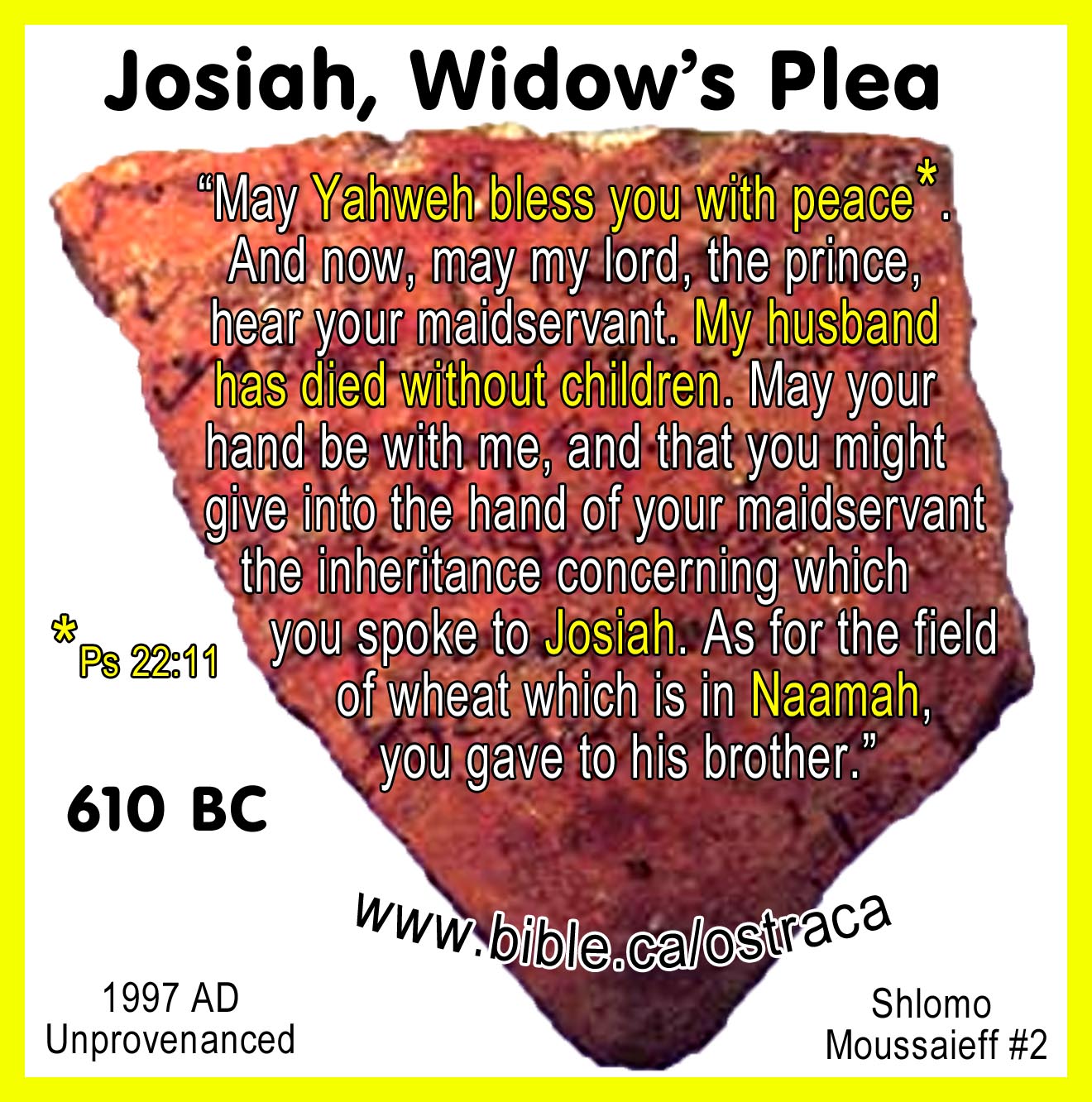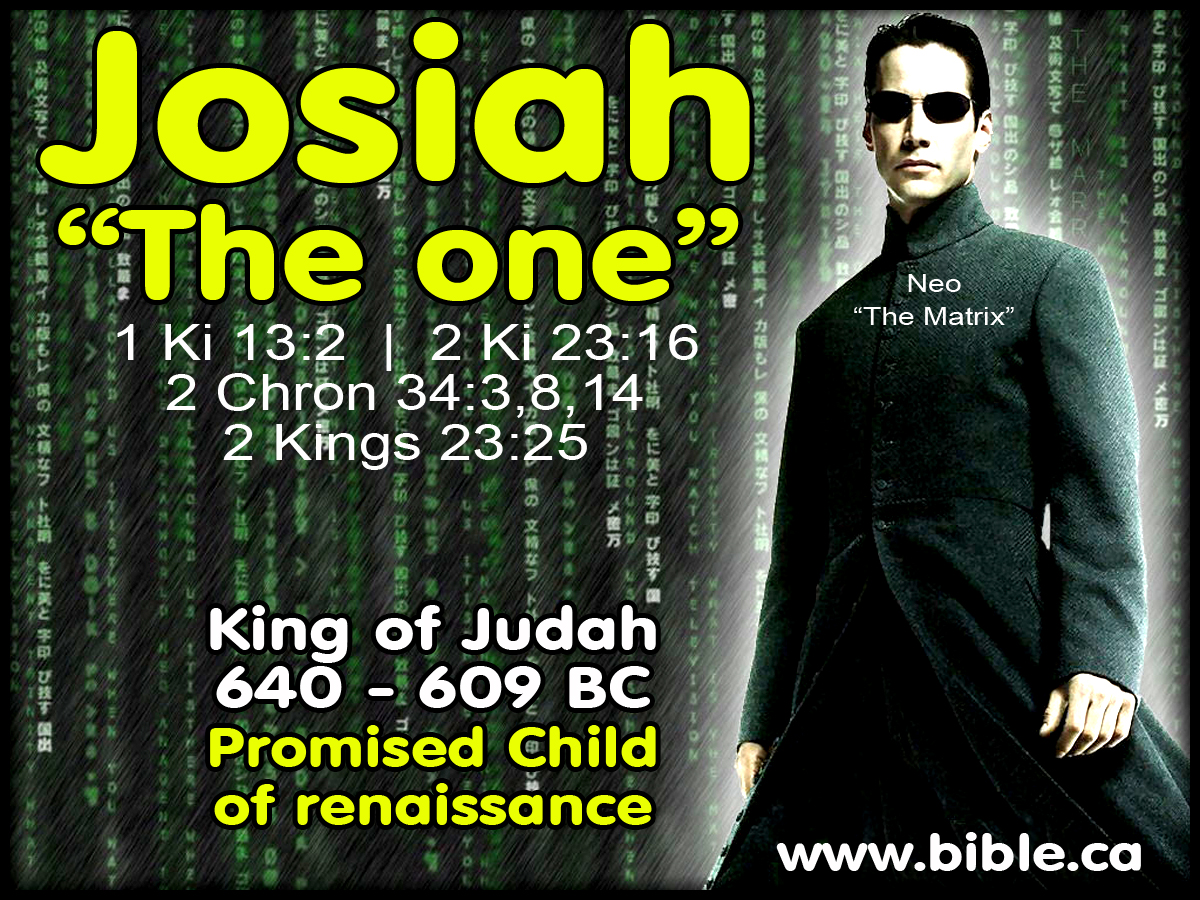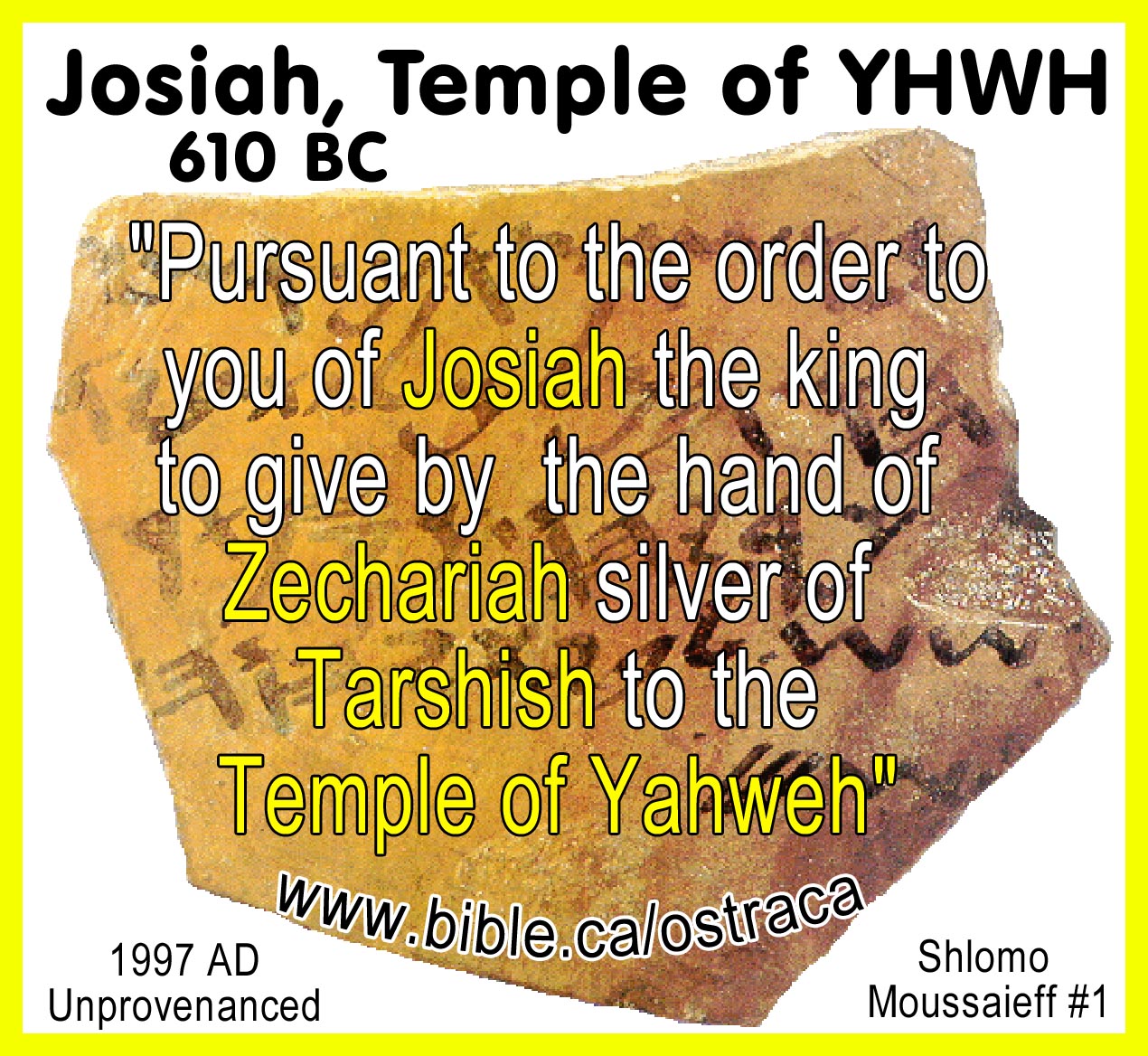Ostraca, Tablets and Inscriptions of the Bible
|
King Josiah Letters Ostraca collection (640 - 609 BC) Shlomo Moussaieff #1 and #2 |
||
|
|
||
King Josiah Ostraca (610 BC)
Introduction:
1. These two ostracon were the written records of communications between individuals and Josiah, king of Judah in Jerusalem.
2. They surfaced from the private antiquities market recently. Since they did not come from an official archeological dig, there is always a chance these are forgeries.
3. However, both are considered genuine. After careful analysis it has been concluded that the only possible king named on the ostraca is King Josiah who reigned 640 - 609 BC. We are certain that this is correct.
|
See also full outline on Josiah |
Authorities commenting on the two ostracon currently in the possession of Shlomo Moussaieff:
1. "This text did not come from regular excavations and the question of authenticity arises here as in other such cases. Because there are no irregularities in script or language, I continue to believe (see Bordreuil, Israel, and Pardee 1996 and 1998) that the text is authentic. To believe the opposite requires the hypothesis that the forger was a master epigrapher, a master grammarian (only an extremely skilled Hebraist could have produced a text that so perfectly reflects the intricacies of Biblical Hebrew morpho-syntax), a master of biblical law, and a master chemist (capable of producing ancient ink and an ancient patina [Rollston apud Bordreuil, Israel, and Pardee 1998:8–9]). The forger would also, however, have had to be cunning enough to produce some unexpected forms, such as {whyh ydk ʿmy} (line 3), which, given the writer’s clear mastery of morpho-syntax elsewhere in the text, must have been either deliberate or a simple scribal error. Ephʿal and Naveh 1998 have argued from certain similarities with phraseology in Biblical Hebrew and epigraphic Hebrew that the text may be a forgery. But such arguments are two-edged: unless inaccuracies are present, such arguments are equally valid in favor of authenticity, i.e., the features singled out are like pre-exilic Hebrew because that is how speakers of pre-exilic Hebrew spoke! In addition, the same authors point out a small number of epigraphic features that are distinctive — but that sort of argument is also two-edged, for a modern forger would have to be not only a master epigrapher but a very devious one to produce previously unattested forms consistently throughout two different texts. Finally, Ephʿal and Naveh turn the tables and refute another argument against authenticity, viz., that certain expressions are characteristic of post-biblical Hebrew (Berlejung and Schüle 1998), by showing that other inscriptions about the authenticity of which there can be no doubt contain such expressions." (Context of Scripture, Dennis Pardee, The Widow’s Plea COS 3.44, p86, 2002 AD)
2. "The name Ashyahu on the “Three Shekels” ostracon is a perfectly good short form of Yo’shiyahu—King Josiah of Judah. We should also note that Josiah’s reign, in the late seventh century B.C.E., matches the date assigned to the ostracon on paleographic grounds by the three scholars who first published it and by Ada Yardeni, one of Israel’s leading specialists in ancient scripts." (Ashyahu: He’s Josiah, Robert Stieglitz, BAR 29:03, 2003 AD)
3. "This is one of two ostraca in the Moussaïeff collection (for the other, see the Widow’s Plea Ostracon, COS 3). It is a five-line inscription that records a royal contribution of silver by a king ʾAshyahu to the temple of Yahweh to be made through the agency of a royal functionary named Zakaryahu. The ostracon is 10.9 cm x 8.6 cm, and is written in Hebrew script that dates on the basis of palaeography to the time of Josiah (640–609 bce): (The Temple Of The Lord Ostracon, Moussaïeff No. 1, Context of Scripture, K. Lawson Younger, Jr., The Widow’s Plea COS 3.44, p86, 2002 AD)
4. "An ostracon whose paleography and names may date it from either the time of Joash or Josiah (640–609 bce) provides insight into the combined royal and religious authority used in the taxation process (Bordreuil, Israel and Pardee). Although dubbed a forgery by some, its authenticity has largely been accepted. The whole is translated, “As King ʿAshayu the king has commanded you to give by the hand of Zakaryahu silver of Tarshish for the house of Yahweh: 3 shekels.” The name King ʿAshayu is widely understood as a form of the name Josiah, although it could also be Joash. Zakaryahu may be the man of 2 Chronicles 24:20 who was murdered by his uncle Joash, or the Levite of 2 Chronicles 35:8 who was in charge of the temple during the reign of Josiah, or someone else. Most interesting is the figure from the time of Josiah who might have been responsible for collecting funds during the temple’s renovation. What is clear is that taxation was carried on under royal authority and that the collection center to which the money went was the temple in Jerusalem." (Taxes, Taxation, R. S. Hess,. Dictionary of the Old Testament: historical books, p953, 2005 AD)
|
King Josiah, Temple of YHWH, Three Shekels
Inscription on pottery shard: "Pursuant to the order to you of Josiah the king to give by the hand of Zechariah silver of Tarshish to the Temple of Yahweh Three Shekels"
Date of ostracon: 610 BC Shlomo Moussaieff #1: 1997 AD Unprovenanced |
|
|
King Josiah, Widow’s Plea
Inscription on pottery shard: “May Yahweh bless you with peace [Ps 22:11]. And now, may my lord, the prince, hear your maidservant. My husband has died without children. May your hand be with me, and that you might give into the hand of your maidservant the inheritance concerning which you spoke to Josiah. As for the field of wheat which is in Naamah, you gave to his brother.”
Date of ostracon: 610 BC Shlomo Moussaieff #2: 1997 AD Unprovenanced |
|
See also full outline on Josiah |
By Steve Rudd: Contact the author for comments, input or corrections.



